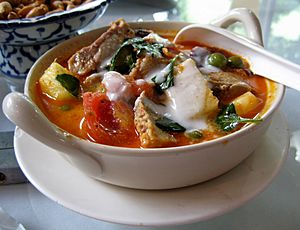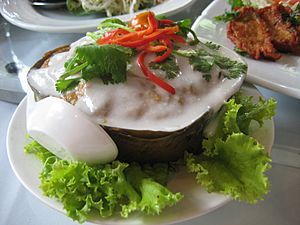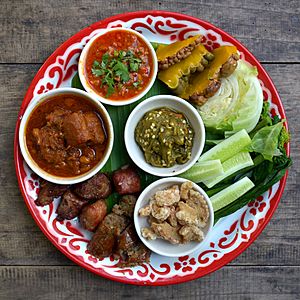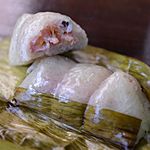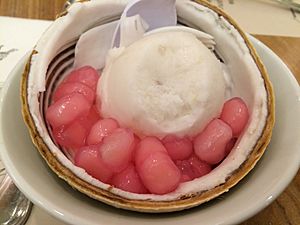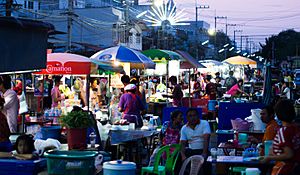Thai cuisine facts for kids
Thai cuisine (Thai: อาหารไทย, ahan thai) is the national food of Thailand. It's known for its fresh ingredients and bold flavors. Thai cooking is all about balancing different tastes like spicy, sour, sweet, salty, and sometimes bitter. It's like a complex song where all the notes work together!
In 2017, seven Thai dishes were voted among the "World's 50 Best Foods" by CNN Travel. Thailand had more dishes on this list than any other country! These included tom yam goong (a spicy shrimp soup), pad thai (fried noodles), som tam (papaya salad), massaman curry, green curry, Thai fried rice, and nam tok mu (grilled pork salad).
Contents
- Exploring Thai Food History
- How Thai Food is Served
- Key Ingredients in Thai Cooking
- Popular Thai Dishes
- Sweet Treats and Desserts
- Drinks of Thailand
- Edible Insects
- Street Food and Markets
- Vegetarian Food in Thailand
- Thai Food Around the World
- Awards for Thai Cuisine
- Cooking Tours and Classes
- Government Efforts to Preserve Thai Food
- See also
Exploring Thai Food History
How Thai Food Changed Over Time
Thai food has been shaped by its neighbors like India, Cambodia, Malaysia, and Indonesia for many centuries. They shared cooking ideas and ingredients.
Ancient Thai people learned how to use spices and make herbal medicines from Indians. Some plants, like sarabhi and phikun, also came from India. Thai food traditions from the Sukhothai (1238–1448) and Ayutthaya (1351–1767) periods were influenced by royal cooking. During the Thonburi period (1767–1782), Chinese food became popular because of busy international trade.
Western influences also played a role, starting in 1511 when Portuguese traders arrived. They brought dishes like foi thong (a sweet egg dessert) and sangkhaya (a coconut custard). These were introduced in the 17th century by Maria Guyomar de Pinha, a woman of mixed Japanese, Portuguese, and Bengali heritage.
The most important Western influence was the chili pepper from the Americas. It arrived in the 16th or 17th century and is now a key ingredient in Thai cooking, along with rice. During the Columbian Exchange, Portuguese and Spanish ships brought new foods like tomatoes, corn, papaya, pineapple, and peanuts to Thailand.
Thai Food Across the Regions
Thai cuisine has five main regional styles, each with its own special dishes:
- Bangkok: Food from the capital city. It has influences from Chinese and Portuguese cooking. Royal cuisine also shaped Bangkok's food.
- Central Thai: From the flat, wet plains where rice grows. Coconut milk is a very important ingredient here.
- Isan (Northeastern Thai): From the drier Khorat Plateau. This food is similar to Laotian food and also influenced by Khmer cooking.
- Northern Thai: From the cooler mountains. This food shares ingredients with Isan cuisine.
- Southern Thai: From the Kra Isthmus, surrounded by tropical seas. Many dishes use lots of coconut milk and fresh turmeric. This region's food is similar to Indian, Malaysian, and Indonesian cooking.
Royal Thai Cuisine
Thai royal cuisine comes from the fancy palace kitchens of the Ayutthaya kingdom (1351–1767 CE). It's known for its detailed cooking, beautiful presentation, and fresh ingredients. Royal cuisine influenced the food of the central Thai plains.
Even though it's fancy, royal Thai cuisine has basic features similar to everyday food. The main differences are the focus on fresh, seasonal ingredients and the complex, delicate way it's prepared.
A French visitor named La Loubère, who visited during King Narai's reign, noted that royal food was similar to village food. The main difference was its beautiful presentation. For example, fish and chicken were served without bones, and vegetables were cut into perfect bite-sized pieces. If beef was used, it was only the tenderloin.
Some royal dishes include ranchuan curry, nam phrik long rue, matsaman curry, and khao chae (rice in jasmine-flavored iced water).
How Thai Food is Served

Traditionally, Thai food was eaten with hands while sitting on mats on the floor. This custom is still found in some homes. Today, most Thais use a fork and spoon. Tables and chairs were introduced during King Mongkut's reign (Rama IV) as part of a move towards Western customs. King Chulalongkorn (Rama V) brought the fork and spoon after visiting Europe in 1897.
When eating, Thais often khluk, which means mixing the flavors and textures of different dishes with rice on their plate. They push food with the fork (held in the left hand) into the spoon (held in the right hand) and then bring it to their mouth. Knives are not usually used at the table. In northern and northeastern Thailand, people often use sticky rice as an edible tool. They shape it into small balls with their right hand and dip it into side dishes.
Chopsticks were not traditionally used by most Thai people, except for Thai Chinese. Thais usually ate with their hands, like people in India. Chopsticks are mainly used in Thailand for Chinese-style noodle soups or at Chinese, Japanese, or Korean restaurants. Stir-fried noodle dishes like phat khi mao and phat Thai are eaten with a fork and spoon.
Thai meals usually include rice (khao) with many different dishes shared by everyone. All dishes, including soups, are served at the same time. It's common to have more dishes than guests. A traditional Thai family meal would have at least five parts:
- A dip or relish for vegetables (khrueang chim), like a spicy nam phrik (chili sauce) or a creamy lon with coconut milk.
- A clear soup (like spicy tom yam or mild tom chuet).
- A curry or stew (any dish starting with kaeng).
- A deep-fried dish.
- A stir-fried dish with meat, fish, seafood, or vegetables.

Most Thai restaurants offer different sauces (nam chim) and condiments. These might include phrik nam pla (fish sauce with lime, chilies, and garlic), dried chili flakes, sweet chili sauce, and sugar. For very spicy dishes, cucumber is often eaten to cool the mouth. Plain rice, sticky rice, or khanom chin (Thai rice noodles) also help balance the spiciness of curries.
When eating alone or in a hurry, single dishes like fried rice or noodle soups are popular. Another option is khao rat kaeng (rice covered with curry), where several dishes are served together on one plate with rice. Eateries specializing in pre-made food often offer this.
Key Ingredients in Thai Cooking

Thai cuisine uses many different ingredients and cooking methods. It's known for its fresh herbs and spices. Common flavors come from garlic, galangal, coriander, lemongrass, shallots, pepper, kaffir lime leaves, shrimp paste, fish sauce, and chilies. Palm sugar adds sweetness, while lime and tamarind provide sourness.
Common meats are pork and chicken, also duck, beef, and water buffalo. Fish, crabs, and shellfish are very important in the Thai diet. Thailand is a big consumer of fish, with people eating about 33.6 kg per person in 2006. Freshwater fish come from rivers and lakes, and seafood from the tropical seas.
Rice, Noodles, and Starches
Like most Asian cuisines, rice is the main food in Thailand. The words for rice and food are the same: khao. To say "eat rice" (kin khao) means to eat food. A common Thai greeting is "Have you eaten rice yet?" (kin khao reu yang?).
Thai farmers used to grow thousands of rice varieties, but this number has decreased.
- Non-glutinous rice (khao chao) is regular rice. A famous Thai type is jasmine rice (khao hom mali), known for its sweet smell. When cooked, it's called khao suai (beautiful rice). This rice is used for fried rice and congee (rice porridge).
- Sticky rice (khao niao) is unique because it cooks up sticky. It's a staple in northern and northeastern Thailand.
- Thai Red Cargo rice is an unpolished long-grain rice with a reddish-brown color and nutty taste.
- Black sticky rice is a dark purple-red sticky rice with a rich nutty flavor, often used in desserts.
Noodles in Thailand are usually made from rice, wheat, or mung bean flour.
- Khanom chin are fresh rice vermicelli noodles made from fermented rice, often eaten with green curry.
- Kuaitiao is a general term for rice noodles, including wide flat noodles (sen yai), narrow flat noodles (sen lek), and thin round rice vermicelli (sen mi).
- Bami are yellow egg noodles made from wheat flour, similar to Chinese mee pok.
- Wun sen (jelly strands) are thin, clear glass noodles made from mung bean flour.
- Kiami (silver needle noodles) are thick, round rice noodles.
Thai noodle dishes are usually individual servings, not shared. Rice flour and tapioca flour are used in desserts or as thickeners.
Pastes and Sauces
- Fish sauce (nam pla) is a clear, very fragrant sauce made from fermented fish. It's a key ingredient that gives Thai food its unique salty flavor.
- Pla ra is another fermented fish sauce, but it's thicker and often contains pieces of fish. It's more pungent than nam pla.
- Shrimp paste (kapi) is a mix of fermented ground shrimp and salt. It's used in chili pastes like nam phrik kapi and is essential for Thai curry pastes.
- Tai pla is a strong sauce from southern Thailand, made from fermented mackerel insides.
- Nam pu is a thick, black paste from northern Thailand, made by boiling mashed rice-paddy crabs. It has a strong, pungent flavor.

- Nam phrik are Thai chili pastes, similar to Indonesian sambals. Each region has its own versions. They are made by crushing chilies with ingredients like garlic and shrimp paste. Some nam phrik are served as dips with vegetables.
- Curry pastes are usually called phrik kaeng or khrueang kaeng. Red curry paste, for example, can be called phrik kaeng phet.
Soy sauces used in Thai cooking come from China: si-io dam (black soy sauce), si-io khao (light soy sauce), si-io wan (sweet soy sauce), and taochiao (fermented whole soybeans). Oyster sauce (namman hoi) is also Chinese and used a lot in stir-fries.
Satay (grilled meat skewers with peanut sauce) is also popular in Thailand.
Vegetables, Herbs, and Spices
Thai dishes use many herbs, spices, and leaves.
- Kaffir lime leaves (bai makrut) give a special flavor to many Thai soups (like tom yam) and curries.
- Galangal (kha) and lemongrass (takhrai) are often used whole or blended into curry pastes with chilies.
- Fresh Thai basil adds a clove-like fragrance to dishes like green curry.
- Other common herbs include coriander (phak chi), spearmint (saranae), holy basil (kraphao), ginger (khing), turmeric (khamin), and pandanus leaves (bai toei).
- Spices like five-spice powder (phong phalo) and curry powder (phong kari) are also used. Northern Thai larb uses a complex spice mix called phrik lap.

Other leaves used include cha-om (young acacia leaves) in omelets and salads, and banana leaves for wrapping food or steaming. Banana flowers are used in salads or curries.
Five main types of chilies are used:
- Phrik khi nu suan (garden mouse-dropping chili): Very small and the hottest.
- Phrik khi nu (mouse-dropping chili): Slightly larger and also very hot.
- Phrik chi fa (sky pointing chili): Green or red, less spicy than the smaller ones.
- Phrik yuak (pale green chili): Very large and the least spicy, used more as a vegetable.
- Phrik haeng (dried chilies): Spicier than the two largest chilies.
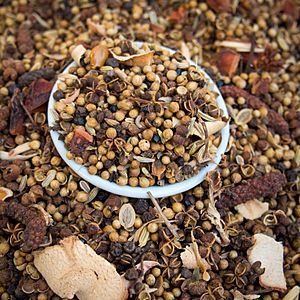
Several types of eggplant (makhuea) are used, like the pea-sized makhuea phuang and the egg-sized makhuea suai. Other common vegetables include yardlong beans (thua fak yao), bean sprouts (thua ngok), bamboo shoots (no mai), tomatoes, cucumbers, Chinese kale (khana), and sweet potatoes.
Many green, leafy vegetables and herbs are eaten raw with meals, such as morning glory (phak bung), Thai basil (horapha), and cabbage (kalamplī).
Different mushrooms are also used, like straw mushrooms (het fang) and shiitake (het hom). Flowers are used as vegetables (like dok khae) or food coloring (like blue dok anchan).
Fruits
Fresh fruit is a big part of the Thai diet and is usually served as dessert after a meal. Fruits are also used in spicy salads like som tam (green papaya salad) and yam som-o (pomelo salad). They appear in soups with tamarind juice and in curries like kaeng kanun (jackfruit curry) and kaeng pet phet yang (grilled duck curry with pineapple). Some Thai chili pastes also use fruits.
Thailand grows many exotic fruits like rambutan, lychees, papaya, jackfruit, mango, mangosteen, longan, pomelo, pineapple, rose apples, and durian. Chantaburi Province is famous for durian production.
Coconuts are very important. Coconut milk is used in curries and desserts, and coconut oil for cooking. The juice of a green coconut is a refreshing drink. The flesh is eaten in sweet or savory dishes. Coconut milk is used a lot in central and southern Thai cooking. In northern and northeastern Thailand, where coconuts don't grow as well, only a few dishes like khao soi use coconut milk.
Fruits like apples, pears, peaches, grapes, and strawberries were not traditionally grown in Thailand. They have become popular in recent decades thanks to Thai Royal Projects that introduced them to farmers in the cooler northern highlands.
Popular Thai Dishes
Many Thai dishes are now famous worldwide. In many dishes, you can swap out the main protein. For example, kaeng phet (red curry) can be made with beef, chicken, pork, duck, tofu, fish, prawns, crab, shellfish, or egg. So, kaeng phet kai is red curry with chicken, and kaeng phet mu is red curry with pork.
Breakfast Favorites
Khao chao (Thai: ข้าวเช้า; "morning rice/food") are breakfast dishes. Often, Thais eat the same dishes for breakfast as they do for lunch or dinner. Single dishes like fried rice, noodle soups, or steamed rice with an omelet are common quick breakfast options from street stalls.
Here are some specific breakfast dishes:
- Chok – a rice porridge, similar to congee in other Asian countries.
- Khao khai chiao – an omelet with white rice, often served with chili sauce.
- Khao tom – a Thai-style rice soup, usually with pork, chicken, fish, or shrimp.
- Pathongko – the Thai version of Chinese deep-fried bread, often eaten with sweet dips.
- Nam taohu – Soy milk often served with sweet jellies.
Single Plate Meals
The term ahan chan diao (Thai: อาหารจานเดียว; "single dish food") refers to meals served on one plate, often with rice. Some eateries specialize in these quick, pre-cooked or made-to-order dishes.
- Phat kaphrao mu rat khao – minced pork fried with chilies, garlic, and holy basil, served with rice.
- Khanom chin kaeng kiao wan kai – fresh Thai rice noodles with green chicken curry.
- Khanom chin nam ngiao – a northern Thai specialty: fermented rice noodles with pork and a tomato-based sauce.
- Khao kha mu – steamed rice with slow-cooked pork leg, mustard greens, and chili sauce.
- Khao khluk kapi – rice stir-fried with shrimp paste, served with sweetened pork and vegetables.
- Khao man kai – rice steamed in chicken stock with boiled chicken and a spicy dipping sauce.
- Khao mu daeng – rice with slices of Thai-style Chinese BBQ pork and gravy.
- Khao phat – fried rice, very common, often with chicken, pork, shrimp, or crab.
* Khao phat American – fried rice with tomato ketchup, served with a fried egg, hot dogs, and bacon.
- Khao soi – a curried noodle soup with coconut milk, popular in northern Thailand.

- Kuaitiao nam and bami nam – noodle soups, eaten any time of day with various proteins and vegetables.
- Kuaitiao rat na – wide rice noodles covered in gravy with meat or seafood.
- Kuaitiao ruea – a strong-flavored rice noodle dish with pork and beef, dark soy sauce, and spices.
- Mi krop – deep-fried rice vermicelli with a sweet and sour sauce.
- Phat khi mao – noodles stir-fried with chilies and holy basil.
- Phat si-io – rice noodles stir-fried with sweet soy sauce and fish sauce, with pork or chicken.
- Phat Thai – pan-fried rice noodles with fish sauce, sugar, lime, peanuts, and egg, with chicken, seafood, or tofu. It was ranked number five on CNNGo's "World's 50 most delicious foods" in 2011.

Ahan Krung Thep (Thai: อาหารกรุงเทพ; "Bangkok food") includes many Thai Chinese dishes.
- Kai phat khing – chicken stir-fried with sliced ginger.
- Kaeng khiao wan – "green curry," a spicy coconut curry with green chilies, Thai basil, and chicken or fish meatballs.
- Kaeng phanaeng – a mild, creamy coconut curry with beef, chicken, or pork.
- Kaeng phet – "red curry," a coconut curry with lots of dried red chilies in the paste.
- Kaeng som – a hot and sour soup/curry, usually eaten with rice.
- Kai phat met mamuang himmaphan – Thai Chinese version of chicken with cashews, stir-fried with dried chilies.
- Phat phak ruam – stir-fried mixed vegetables.
- Phat phrik – often nuea phat phrik: beef stir-fried with chili.
- Phat khana mu krop – gailan stir-fried with crispy pork.
- Phat kaphrao – beef, pork, prawns, or chicken stir-fried with Thai holy basil, chilies, garlic, and soy sauce.
- Suki – a Thai version of Chinese hot pot.
- Thot man – deep-fried fishcakes made from knifefish (thot man pla krai) or shrimp (thot man kung).
- Tom chuet or kaeng chuet – a clear soup with vegetables and sometimes cellophane noodles or silken tofu.
- Tom kha kai – hot, spicy soup with coconut milk, galangal, and chicken.
- Tom yam – hot and sour soup with meat. Tom yam goong (with shrimp) is very famous.
Ahan Phak Klang (Thai: อาหารภาคกลาง; "central region food") is usually eaten with non-glutinous jasmine rice.
- Chuchi pla kaphong – snapper in a thick red curry sauce.
- Ho mok pla – a steamed fish pâté or soufflé with spices, coconut milk, and egg, served in a banana leaf cup.
- Pla nueng manao – steamed fish with a spicy lime juice dressing.
- Pla sam rot – "three flavors fish": deep-fried fish with a sweet, tangy, and spicy tamarind sauce.
- Pu cha – cooked crab meat, pork, garlic, and pepper, deep-fried in crab shells and served with a spicy sauce.
- Som tam – grated green papaya salad, pounded with a mortar and pestle. There are variations with peanuts, pickled crab, or fermented fish. It's usually eaten with sticky rice or Khanom chin (rice noodles).
- Yam – a general name for many sour Thai salads, like yam wunsen (glass noodle salad) or yam thale (seafood salad). The dressing usually has shallots, fish sauce, tomato, lime juice, sugar, and chilies.
- Yam pla duk fu – crispy fried catfish with a spicy, sweet-and-sour green mango salad.


Ahan Isan (Thai: อาหารอีสาน; "Isan food") is similar to Laotian food because of close cultural ties. The main food in Isan is glutinous rice. Most Isan food is spicy and uses local farm ingredients.
- Kai yang – marinated, grilled chicken.
- Lap – a traditional Lao salad with meat, onions, chilies, roasted rice powder, and mint.
- Nam chim chaeo – a sticky, sweet, and spicy dipping sauce made with dried chilies, fish sauce, palm sugar, and roasted rice flour. Often served with grilled pork.
- Phat mi Khorat – a stir-fried rice noodle dish, often served with papaya salad.
- Tam maak hoong or Som tam pla ra – spicy papaya salad, spicier and less sweet than central Thai som tam, and includes fermented fish sauce.
- Nam tok mu – made with pork or beef, similar to Lap, but with thinly sliced meat instead of minced.
- Tom saep – Northeastern-style hot and sour soup.
- Yam naem khao thot or naem khluk – a salad made of crumbled rice-and-curry croquettes and sour pork sausage.

Ahan Phak Nuea (Thai: อาหารภาคเหนือ; "northern region food") shares dishes with neighboring Shan State in Burma and with Laos. Like Isan, glutinous rice is the main food here.
- Aep – chopped meat, small fish, or edible insects mixed with eggs and spices, slow-grilled in banana leaves.
- Kaeng hang-le – a Burmese-influenced stewed pork curry with peanuts, dried chilies, and tamarind juice, but no coconut milk.
- Kaeng khae – a spicy curry with herbs, vegetables, and meat (chicken, water buffalo, pork, or frog). It does not contain coconut milk.
- Kaeng khanun – a pork curry stewed with green jackfruit. Like other northern Thai curries, it has no coconut milk.
- Kaep mu – deep-fried crispy pork rinds, often eaten with chili pastes like nam phrik num.
- Lab nuea – a drier, smokier northern Thai larb that doesn't use lime or fish sauce. It's flavored with ground dried chilies and spices like cumin and cinnamon.
- Nam phrik num – a chili paste made from pounded green chilies, shallots, garlic, and coriander leaves; eaten with steamed and raw vegetables, and sticky rice.
- Nam phrik ong – like a thick Bolognese sauce, made with dried chilies, minced pork, and fermented soybeans; eaten with vegetables and sticky rice.
- Sai ua – a grilled sausage of ground pork mixed with spices and herbs, often served with fresh ginger and chilies.
Ahan Phak Tai (Thai: อาหารภาคใต้; "southern region food") shares some dishes with northern Malaysia. Southern Thais eat non-glutinous rice as their main food.
- Kaeng matsaman – "Massaman curry," an Indian-Malay style beef curry with roasted dried spices. In 2011, CNNGo ranked Massaman as the number one most delicious food in the world.
- Kaeng som (southern Thai name) or kaeng lueang (central Thai name) – a sour curry with fish, vegetables, or fruit, made sour with tamarind juice.
- Kaeng tai pla – a thick, sour vegetable curry with turmeric and shrimp paste, often containing roasted fish or fish insides, bamboo shoots, and eggplant.
- Khao mok – Thai-Malay style biryani, a specialty of southern Thailand's Malay community.
- Khao yam – a rice salad from southern Thailand.
- Khua kling – a dry, spicy curry made with minced or diced meat, often served with fresh chilies and shredded kaffir lime leaves.
- Sate – grilled meat (pork or chicken) with cucumber salad and peanut sauce.
Sweet Treats and Desserts
Khong Wan (Sweet Things)
(Thai: ของหวาน; khong wan) Most Thai meals end with fresh fruit. Sometimes, sweet snacks, often eaten between meals, are also served as dessert.
- Bua loi – taro and pumpkin balls in coconut milk.
- Chaokuai – grass jelly served with shaved ice and brown sugar.
- Kanom khrok – coconut-rice pancakes, an ancient Thai dessert.
- Khanom khrok bai toey – ancient Thai dessert shaped like flowers.
- Khao tom mat – sticky rice, coconut milk, and banana wrapped in a leaf and steamed.
- Khanom chan – multi-layered pandanus-flavored sticky rice flour with coconut milk.
- Khanom dok chok – crispy lotus blossom cookie.
- Khanom farang kudi chin – a sponge cake of Portuguese origin, baked in a wood-fired oven.
- Khanom ja mongkut – one of nine lucky Thai sweets, made from egg yolks, coconut milk, sugar, and flour.
- Khanom mo kaeng – a sweet baked pudding with coconut milk, eggs, and palm sugar.
- Khanom tan – palm-flavored mini cakes topped with shredded coconut.
- Khanom tom – a rice flour dumpling filled with palm sugar and shredded coconut.
- Khanom thuai talai – steamed sweet coconut jelly and cream.
- Khao lam – cake made from steamed rice with beans, grated coconut, and coconut milk.
- Khao niao mamuang – sticky rice cooked in sweetened coconut milk, served with ripe mango.
- Kluai buat chi – bananas in coconut milk.
- Lot chong nam kathi – pandan-flavored rice flour noodles in coconut milk, similar to Indonesian cendol.
- Mamuang kuan – preserved mango sweets, sold as flat wafers or rolls.
- Roti saimai – Thai-style cotton candy wrapped in a thin pancake.
- Ruam mit – mixed ingredients like chestnuts, jackfruit, and tapioca in coconut milk.
- Sangkhaya – coconut custard.
- Sangkhaya fak thong – egg and coconut custard served with pumpkin.
- Sarim – multi-colored mung bean flour noodles in sweetened coconut milk with crushed ice.
- Tako – jasmine-scented coconut pudding in pandanus leaf cups.
- Thong yip – "pinched gold egg yolks," one of the nine lucky Thai desserts.
- Thong yot – sweet round egg ball, another lucky Thai dessert.
Ice Cream in Thailand
Ice cream came to Thailand during King Rama V's reign when the first ice cream machine arrived. At first, ice cream was a treat for the wealthy. It was made from coconut water mixed with ice, which had to be imported from Singapore. Over time, coconut milk replaced coconut water, and ice cream became more common.
The "ice cream tube" became popular during King Rama VII's reign. Ingredients were put in a zinc tube, shaken until solid, and then served on a stick. Mobile vendors sold it using dry ice and salt to keep it cold. Later, ice cream was sold in small cups.
Aitim tat ("cut ice cream") was very popular about 30 years ago. It came in rectangular bars, sliced by the vendor, and served with two wooden sticks. It was made from milk, coconut milk, flour, sugar, and artificial flavors.
Drinks of Thailand
Khrueang duem (Thai: เครื่องดื่ม; "beverages")
- Cha yen – Thai iced tea.
- Krating Daeng – an energy drink that inspired Red Bull.
- Nam maphrao – the juice of a young coconut, often served inside the coconut.
- Nam matum – a refreshing drink made from the Bael tree fruit.
- Nom yen – a drink made from sala syrup and hot milk.
- Oliang – a sweet Thai black iced coffee.
- Satho – a traditional rice wine from the Isan region.
Other alcoholic drinks include Hong Thong, Phraya, Regency, Mekhong, and Sang Som. Popular Thai beers are Singha and Chang.
Edible Insects
Eating insects is common in Thailand, especially in Isan and the north. Many markets sell deep-fried grasshoppers, crickets (ching rit), bee larvae, silkworms (non mai), ant eggs (khai mot), and termites. Some larvae are even called "express train" (rot duan) because of their shape!
Most deep-fried insects taste quite mild. However, the maeng da (Lethocerus indicus), a giant water bug, has a very strong taste, sometimes compared to gorgonzola cheese. This bug is famously used in a chili dip called nam phrik maeng da. Ant eggs and silkworms are boiled in soup in Isan or used in egg dishes in northern Thailand.
Street Food and Markets
Street food became popular in Thailand in the 1960s. Bangkok is known as one of the best street food cities in the world.
You can find almost any Thai dish sold by a street vendor or at a market. Some vendors specialize in just one or two dishes, while others offer a full menu. Many dishes are made to order, like quick stir-fries with rice (e.g., phat kaphrao) or quick curries.
Noodles are a popular street food. Chinese-style noodle soups, fried noodles, and fermented Thai rice noodles (khanom chin) with different curries are common. Som tam (green papaya salad) and sticky rice are sold almost everywhere, often with grilled chicken. In many cities, you'll find stalls selling sweet roti (a thin, fried dough) with fillings like banana, egg, or chocolate.
In the evenings, mobile street stalls often set up outside bars, selling kap klaem ("drinking food"). Popular kap klaem include grilled items like sun-dried squid, meat skewers, or fried insects. Peeled and sliced fruits are also sold from carts, kept fresh on crushed ice. Salapao, steamed buns filled with meat or sweet beans, are also common.
Food markets are large open-air places with many permanent stalls. They are like a collection of street stalls, each with its own tables. Some are like food courts in shopping malls. Night food markets appear in parking lots or along busy streets in the evenings.
Dishes sold at wet markets are often pre-cooked. Many Thais buy food from these markets or street vendors to eat at work or take home. It's common to see people carrying full meals, neatly packed in plastic bags, to share with friends and family. These places are great for finding regional and seasonal foods.
Vegetarian Food in Thailand
While the Vegetarian Festival is celebrated yearly, finding pure vegetarian food in regular Thai restaurants can be hard. Most traditional Thai curries contain shrimp paste, and fish sauce is used in many dishes. Vegetarian restaurants use substitutes for these ingredients.
In towns and cities, you can find traditional Buddhist vegetarian food at special restaurants. These places have yellow signs with the word che (Thai: เจ) or ahan che (Thai: อาหารเจ) written in red. This food is usually vegan, meaning no meat, seafood, or certain strong-tasting vegetables. Many Indian restaurants also offer vegetarian dishes. Because more tourists want vegetarian food, many hotels and restaurants now have vegetarian Thai dishes on their menus. People who eat fish but no other meat (pescatarians) will find many options in Thai cuisine.
Thai Food Around the World
Thai cuisine became famous worldwide starting in the 1960s, when Thailand became a popular tourist spot and US troops arrived during the Vietnam War. The number of Thai restaurants grew quickly in cities like London. The first Thai restaurant in the US, "Chada Thai," opened in Denver, Colorado, in 1959.
The global popularity of Thai food helps promote tourism and exports of Thailand's farm products. This is part of a plan called "gastrodiplomacy." In 2009, the Tourism Authority of Thailand held a conference to discuss promoting Thai cuisine.
The Thai government launched the "Kitchen of the World" campaign to promote Thai food internationally. They offered loans and training for people wanting to open Thai restaurants overseas. They also created the "Thai Select" program to certify restaurants that use ingredients imported from Thailand. By 2011, there were over 10,000 Thai restaurants worldwide.
A 2003 survey showed that Thai cuisine ranked fourth when people were asked to name an ethnic cuisine, after Italian, French, and Chinese. When asked about their favorite cuisine, Thai food came in sixth, after the top three, and Indian and Japanese.
In CNN's "World's 50 most delicious foods" list in 2011, som tam was 46th, nam tok mu was 19th, tom yam kung was 8th, and massaman curry was ranked number one!
Awards for Thai Cuisine
Thai chefs have won many awards in international cooking competitions. For example, the Thailand Culinary Academy won gold medals at the IKA Culinary Olympic in Germany in 2012.
Some restaurants specializing in Thai cuisine, even those owned by non-Thai chefs, have received Michelin stars. These include "Nahm" in London, "Kiin Kiin" in Copenhagen, and "Pok Pok NY" in New York City.
Cooking Tours and Classes
Culinary tours and cooking courses in Thailand have become very popular. Many companies offer food tours, and tourists often take cooking classes at hotels or cooking schools.
Government Efforts to Preserve Thai Food
The Thai government believes that poor quality Thai food served abroad can harm the country's reputation. To ensure quality, they have started programs to create standards for Thai food.
In 2013, the government launched the Rod Thai Tae ('authentic Thai taste') program and the "Thai Delicious" project. The "Thai Delicious" project aimed to:
- Create standard recipes for authentic Thai dishes.
- Develop special equipment to measure taste and flavors.
- Create ready-to-cook Thai food products for export.
- Offer food certification and training for chefs.
They published 11 "authentic" recipes for dishes like tom yam gung, pad Thai, and Massaman curry. They even developed an "e-delicious machine" to measure taste. This machine would compare food to a standard recipe and give a score. If a dish scored below 80, it was "not up to standard." Restaurants following official recipes could use a "Thai Delicious" logo. However, this project was later stopped.
Some people criticized the project, saying that "Standardization is the enemy of Thai food." But others felt that the quality of Thai food abroad was declining and needed to be fixed.
In 2018, Thailand's Ministry of Commerce started the "Thai Select" project. It gives certificates (gold, red, or orange grades) to Thai restaurants to help tourists choose good places to eat.
The Culture Ministry also announced plans to protect authentic Thai cuisine from foreign influences between 2020 and 2024. They want to preserve Thai culinary art, which has unique preparation methods and recipes passed down through generations.
Efforts to Reduce Salt
Thai people consume a lot of salt, about twice the recommended amount by the WHO. Thai street food is one of the main reasons for this high salt intake. The Public Health Ministry has started a program to reduce the population's salt consumption by 30 percent.
See also
 In Spanish: Gastronomía de Tailandia para niños
In Spanish: Gastronomía de Tailandia para niños





